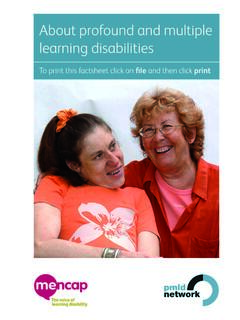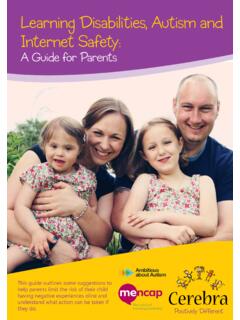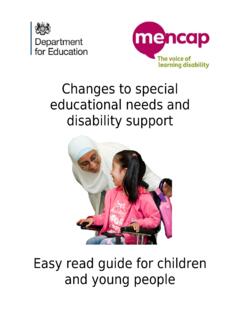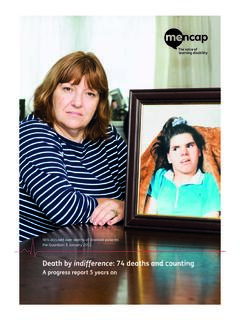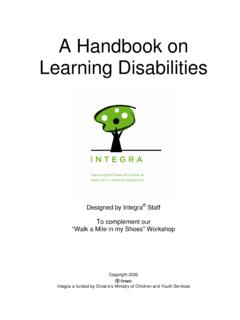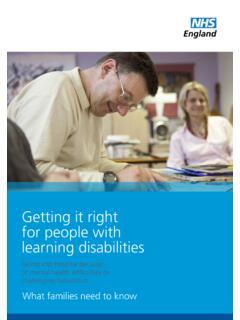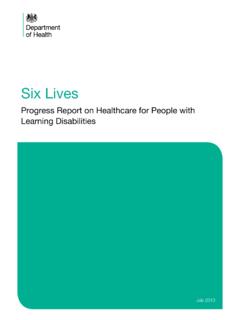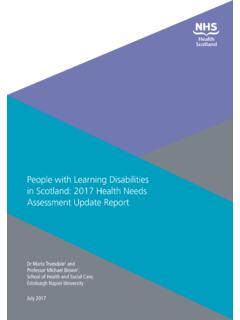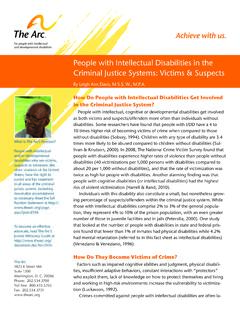Transcription of ABILITY - Mencap
1 TIT U DE S TO. CHANGING AT ILI TY. D. learning nceIS A B. ide A review of the ev Authors: Dr Katrina Scior University College London Dr Shirli Werner Paul Baerwald School of Social Work and Social Welfare, Hebrew University Proposed for publication by Mencap . of Jerusalem Copyright 2015 Scior & Werner. Changing Attitudes To learning Disability 2. Contents Contents Executive Summary 4. Introduction 5. What do we mean by attitudes? 6. Attitudes to learning disability 8. What has been done to tackle negative attitudes?
2 10. Limitations of research on attitude change 14. What can we learn from efforts to improve attitudes to learning disability reported to date? 16. Conclusions and recommendations for action 18. Recommendations 20. References 22. 3. Changing Attitudes To learning Disability Executive Summary Improving attitudes to people with learning health care providers), or those that have disabilities * is a key priority for Mencap . This a potential role in countering negative review was written to help Mencap and other attitudes and discrimination (the media, bodies to define this area by providing an the police, employers, legislators).
3 Most overview of attempts to change attitudes to such interventions have been small-scale, individuals with learning disabilities , identifying used unrepresentative samples, and have gaps in the evidence and making suggestions not been rigorously evaluated, making it for a way forward. Our conclusions can be difficult to draw firm conclusions. summarised as follows: Evidence from the learning disability field and others suggests that contact with Increased community inclusion in countries people with learning disabilities has an such as the UK appears to have led to more important role in changing attitudes and positive attitudes to people with learning reducing prejudice.
4 At present we do not disabilities . Nonetheless, children and know what quality, quantity and type of adults with learning disabilities are still contact is most likely to change attitudes. frequently excluded from various fields of life, activities and opportunities, regularly It is likely that contact needs to occur have to face name-calling, bullying and alongside education about learning being stared at, and are frequently the disability, the range of abilities and needs targets of hostility. of individuals with learning disabilities , and their capabilities to counter misconceptions There is very limited representative**.
5 And challenge negative stereotypes. general population data to draw on as baseline of attitudes that interventions can The effects of attitude change interventions be measured against. on real life behavior are very under- researched. Confusion as to what learning disability'. constitutes, and about different terms In this report, we present a multi-level in use, appears widespread, as do model that may help in planning and misconceptions about the capabilities of integrating future work that can do justice people with learning disabilities .
6 To address the complexity of changing attitudes to individuals with learning Attempts to change attitudes and counter disabilities . discrimination have targeted children and adults in the general population, as well as specific groups more likely to come into contact with people with learning disabilities (care staff, teachers, *In this report the term learning disability' is used as it is the most commonly used term in the UK to refer to what in many other countries is referred to as intellectual disability', significant impairments in cognitive and adaptive functioning of early outset.)
7 ** Representative data or samples are those where the characteristics of the sample (the people interviewed or surveyed). accurately reflect those of the entire population of interest. For example, a representative sample of the UK population would contain people with the same range of demographic characteristics as the whole UK population. 4. Introduction Introduction Policies, service provision and societal views of violence2. Not only are they often the easy people with learning disabilities have changed targets of verbal and physical harassment and substantially over the last hundred years.
8 Up abuse, in some cases they are the victims of to the 1970s large numbers of children and horrific hate crimes seemingly for no reason adults with learning disabilities were confined other than appearing different and less able in institutions in the UK. Now almost all children to defend themselves3 4. A recent review with learning disabilities live with their families, concluded that people with mental health and most attend inclusive schools*. Among problems and/or learning disabilities are the adults with learning disabilities many live in most likely section of the population to be their own homes with varying levels of support, affected by targeted violence and hostility5.
9 And few remain in segregated educational, day More needs to be done to tackle negative care or residential provision. attitudes to individuals with learning Despite increased physical integration, disabilities , and to break down barriers that individuals with learning disabilities often still prevent people with learning disabilities from feel socially excluded and exposed to negative being accepted within society, and from perceptions and unwelcome behaviours. accessing a wide range of opportunities and Many are prevented from equal participation experiences taken for granted by people in education, employment, leisure and social without disabilities .
10 These aims are enshrined pursuits. The fact that discrimination against in the UN Convention on the Rights of Persons people with learning disabilities is still an with disabilities , which promotes a rights everyday reality is illustrated by estimates that based perspective instead of, for example, the only 7% of adults with learning disabilities charity discourse so long applied to people with are in any form of paid employment in the learning disabilities . UK1. Furthermore, nine out of ten children and adults with learning disabilities report that they have been the target of bullying, almost five in ten that they have experienced verbal abuse and one in four has experienced physical *The proportion of children educated in special schools stood at per cent in 2007 but had risen to per cent by 2013.
